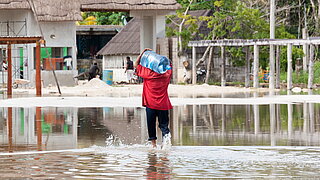Risk management

Innovative insurance solutions for insuring against weather risks
Climate models (IPCC 2014) indicate that climate change is causing changes in weather events in a number of regions around the globe. These events may include prolonged periods of drought, heatwaves, torrential rain or storms. Extreme weather events of this kind are capable of having devastating and direct impacts on people’s lives, businesses and infrastructure or the wider economy in affected regions. If extreme weather causes crops to fail, smallholders may lose the economic basis for their livelihoods, while the public funds becomes stretched to the limit by providing disaster relief and financing the recovery of the regions affected.
Reducing economic risks
Insurance policies offering protection against the effects of climate-driven extreme weather can minimise economic risk, while at the same time offering rapid support to people seeking to rebuild their businesses. This applies at both an individual and macroeconomic level. In particular, IKI is funding projects that combine insurance products with preventive measures for adapting to climate change. This offers a chance to reduce potential damage following the occurrence of extreme weather events while providing support for rapid recovery from damage and losses.
In selected regions, many IKI projects are working to develop innovative insurance solutions and risk provisioning strategies. These projects are also financing the development of legal frameworks, promoting cooperation from policymakers and insurance companies, and supporting the development of catastrophe models for mitigating damage and losses caused by extreme weather. In this way, the projects are improving both income and food security for local populations, as well as creditworthiness and purchasing power for individuals and businesses. Simultaneously, this work also makes an important contribution to the quantification of weather-driven damage and losses—data that is usable by stakeholders from the insurance industry, government and the wider economy.
Selected projects
Funding area
The link has been copied to the clipboard



